Spatiotemporal Changes in Precipitation during the Summer Maize Growing Season in the North China Plain and Analysis of Its Causes
Abstract
:1. Introduction
2. Overview of the Study Area
3. Data and Methods
3.1. Data Sources
3.2. Determination of the Summer Maize Growing Season
3.3. Study Methods
3.3.1. Mann–Kendall Trend Test
3.3.2. Precipitation Barycenter
4. Results and Discussion
4.1. Temporal Variation Characteristics of Precipitation
4.1.1. Precipitation Trend Analysis
4.1.2. Precipitation Cyclicity Analysis
4.2. Spatial Distribution Characteristics of Precipitation
4.2.1. Spatial Distribution of Precipitation
4.2.2. Precipitation Spatial Distribution Types
4.2.3. Precipitation Barycenter
4.3. Effects of Climate Change on Precipitation
4.3.1. Effects of ENSO Warm and Cold Events on Precipitation
4.3.2. Teleconnection between Climatic Factors and Precipitation Changes
5. Conclusions
- (1)
- Annual precipitation fluctuations during the summer maize growing season in the North China Plain from 1960–2020 were high and showed an insignificant decreasing trend. Among the three developmental stages, precipitation during the jointing–flowering stage was the lowest and the decreasing trend was the highest. Dry–wet alternations in precipitation were detected during the summer maize growing season in the North China Plain and most years underwent 2.5 or three dry–wet alternations.
- (2)
- The spatial distribution of precipitation during the summer maize growing season in the North China Plain was not uniform and there were large differences detected between the three developmental stages. The precipitation distribution pattern of the sowing–jointing stage was mainly “North–South”, the zero contour was near 36° N, and the jointing–flowering and flowering–maturation stages were mainly “global” with phases that were the opposite of one another. The spatial distribution layout of precipitation barycenters during the three developmental stages of summer maize showed a South–North direction with low dispersion and significant directionality. Precipitation barycenters in the recent 61 years during the jointing–flowering stage showed a significant southward migration trend. The precipitation barycenters during the sowing–jointing and flowering–maturation stages showed southeast and northeast migration, respectively, but these trends were not significant.
- (3)
- A negative correlation was detected between the precipitation of different summer maize developmental stages in the North China Plain and the occurrence of warm events. A positive correlation was detected between the precipitation during the flowering–maturation stage and cold events. Precipitation changes under warm and cold events did not have significant relationships with the grades of warm and cold events. During the entire growing season, PDO and precipitation had the highest correlation. PDO was the main factor that affected precipitation changes during the summer maize growing season in the North China Plain in the past 61 years.
Author Contributions
Funding
Institutional Review Board Statement
Informed Consent Statement
Data Availability Statement
Conflicts of Interest
References
- Shi, W.; Huang, S.; Liu, D.; Huang, Q.; Han, Z.; Leng, G.; Wang, H.; Liang, H.; Li, P.; Wei, X. Drought-flood abrupt alternation dynamics and their potential driving forces in a changing environment. J. Hydrol. 2021, 597, 126179. [Google Scholar] [CrossRef]
- Han, L.; Zhang, Q.; Ma, P.; Wang, Y.; Huang, T.; Jia, J.; Wang, X.; Wang, X.; Liu, W.; Li, D.; et al. Characteristics of drought disasters risk in the Yellow River Basin under the climate warming. J. Desert Res. 2021, 41, 225–234. [Google Scholar]
- Pascolini-Campbell, M.; Reager, J.T.; Chandanpurkar, H.A.; Rodell, M. A 10 percent increase in global land evapotranspiration from 2003 to 2019. Nature 2021, 593, 543–547. [Google Scholar] [CrossRef] [PubMed]
- Frich, P.L.; Lv, A.; Della-Marta, P.; Gleason, B.; Haylock, M.; Tank, A.M.G.K. Observed coherent changes in climatic extremes during 2nd half of the 20th century. Clim. Res. 2002, 19, 193–212. [Google Scholar] [CrossRef]
- New, M.; Hewitson, B.; Stephenson, D.B.; Tsiga, A.; Kruger, A.; Manhique, A.; Gomez, B.; Coelho, C.A.S.; Masisi, D.N.; Kululanga, E.; et al. Evidence of trends in daily climatic extremes over southern and west Africa. J. Geophys. Res. Atmos. 2006, 111, D14102. [Google Scholar] [CrossRef]
- Wang, Y.; Chen, X.; Yan, F. Spatial and temporal variations of annual precipitation during 1960–2010 in China. Quat. Int. 2015, 380, 5–13. [Google Scholar] [CrossRef]
- Ren, G.; Ren, Y.; Zhan, Y.; Sun, X.; Liu, Y.; Chen, Y.; Wang, T. Spatial and temporal patterns of precipitation variability over China’s Mainland II: Recent trends. Adv. Water Sci. 2015, 26, 451–465. [Google Scholar]
- Yao, H.M.; Wu, Y.X.; Guan, T.S. Diagnose of precipitation evolution trend in China and new facts. Adv. Water Sci. 2013, 24, 1–10. [Google Scholar]
- Zhou, D. Analysis of Spatiotemporal Changes during Droughts in Northern China in 1961–2013 and Analysis of Its Causes; Northwest Normal University: Lanzhou, China, 2015. [Google Scholar]
- Guo, H.; Li, M.; Wang, L.; Wang, Y.; Zang, X.; Zhao, X.; Wang, H.; Zhu, J. Evaluation of Groundwater Suitability for Irrigation and Drinking Purposes in an Agricultural Region of the North China Plain. Water 2021, 13, 3426. [Google Scholar] [CrossRef]
- Cui, Y.; Zhang, B.; Huang, H.; Wang, X.; Zeng, J.; Jiao, W.; Yao, R. Identification of Seasonal Sub-Regions of the Drought in the North China Plain. Water 2020, 12, 3447. [Google Scholar] [CrossRef]
- Wang, L.J. Drought and High Temperature Occurrence Characteristics and Effects on Yield in Summer Maize Season in the North China Plain; China Agricultural University: Beijing, China, 2018. [Google Scholar]
- Cao, Y.Q.; Wang, Y.H.; Feng, X.X.; Qiao, H. Spatial and temporal analysis of drought in different growth stages of summer corn in hebei province. J. North China Univ. Water Resour. Electr. Power 2020, 41, 1–9. [Google Scholar] [CrossRef]
- Zhao, Z.L.; Luo, Y.; Yu, J.L.; Luo, X.Q.; Yang, Y.Y. Analysis of precipitation variation characteristics and barycenter shift in Guizhou Plateau during 1960–2016. J. Geo-Inf. Sci. 2018, 20, 1432–1442. [Google Scholar]
- Wu, K.; Wang, X.L.; Xu, Y.; Wang, G.X.; Wu, Y.X. New facts about evolution of spatial and temporal pattern of precipitation over Chinese mainland. South-North Water Transf. Water Sci. Technol. 2017, 15, 30–36. [Google Scholar]
- Fan, L.; Lu, C.; Yang, B.; Chen, Z. Long-term trends of precipitation in the North China Plain. J. Geogr. Sci. 2012, 22, 989–1001. [Google Scholar] [CrossRef]
- Yang, J.; Gong, D.; Wang, W.; Hu, M.; Mao, R. Extreme drought event of 2009/2010 over southwestern China. Meteorol. Atmos. Phys. 2012, 115, 173–184. [Google Scholar] [CrossRef]
- Zhou, C.C.; Zhang, Q.T. The connotations of water resources crisis and the analysis of Huang-huai-hai Plain. Territ. Nat. Resour. Study 2004, 1, 79–80. [Google Scholar] [CrossRef]
- Tian, Y.M.; Bao, Z.X.; Song, X.M.; Mo, Y.C.; Wang, G.Q.; Liu, C.S. Analysis of variation characteristics of groundwater reserves and buried depth in Huang-huai-hai Plains. China Rural Water Hydropower 2021, 12, 115–121. [Google Scholar]
- Xia, Y.; Li, H.; Wang, B.; Ma, Z.; Guo, X.; Zhao, K.; Zhao, C. Characterization of Shallow Groundwater Circulation Based on Chemical Kinetics: A Case Study of Xiong’an New Area, China. Water 2022, 14, 1880. [Google Scholar] [CrossRef]
- Liu, X.H. Farming system and farming system regional planning in China. J. China Agric. Resour. Reg. Plan. 2002, 23, 11–15. [Google Scholar] [CrossRef]
- Gao, P.; Geng, G.P.; Wang, H.W.; Li, Z.J.; Ning, T.Y. Study on the Partitions of Modern Farming System and Its Structural Characteristics in Shandong Province. Crops 2010, 3, 11–14. [Google Scholar]
- Chen, F.; Jiang, Y.L.; Yin, X.G. Development of China’s farming system and adjustment of zoning scheme. Chin. J. Agric. Resour. Reg. Plan. 2021, 42, 1–6. [Google Scholar]
- Pirnia, A.; Golshan, M.; Darabi, H.; Adamowski, J.; Rozbeh, S. Using the Mann-Kendall test and double mass curve method to explore stream flow changes in response to climate and human activities. J. Water Clim. Chang. 2018, 10, 725–742. [Google Scholar] [CrossRef]
- Cazelles, B.; Chavez, M.; Berteaux, D.; Ménard, F.; Vik, J.O.; Jenouvrier, S.; Stenseth, N.C. Wavelet analysis of ecological time series. Oecologia 2008, 156, 287–304. [Google Scholar] [CrossRef]
- Nourani, V.; Behfar, N.; Dabrowska, D.; Zhang, Y. The Applications of Soft Computing Methods for Seepage Modeling: A Review. Water 2021, 13, 3384. [Google Scholar] [CrossRef]
- Sun, M.D.; Kim, G.; Lei, K.; Wang, Y. Evaluation of Technology for the Analysis and Forecasting of Precipitation Using Cyclostationary EOF and Regression Method. Atmosphere 2022, 13, 500. [Google Scholar] [CrossRef]
- Huang, T.T.; Lin, Q.X.; Wu, Z.Y.; Wang, Y.Q. Spatial and Temporal Characteristics of Drought in the Yellow River Basin and Their Correlation with ENSO. Yellow River 2021, 43, 52–58. [Google Scholar]
- Wu, K. SPEI-Based Study on the Effects of ENSO Events on Droughts in Various Areas in Liaoning Province; Shenyang Agricultural University: Shenyang, China, 2018. [Google Scholar]
- Hu, Q.Y. Impacts of Climate Change and Human Activities on Dryness and Wetness in Different Sub-Regions of China; Northwest A & F University: Xianyang, China, 2021. [Google Scholar]
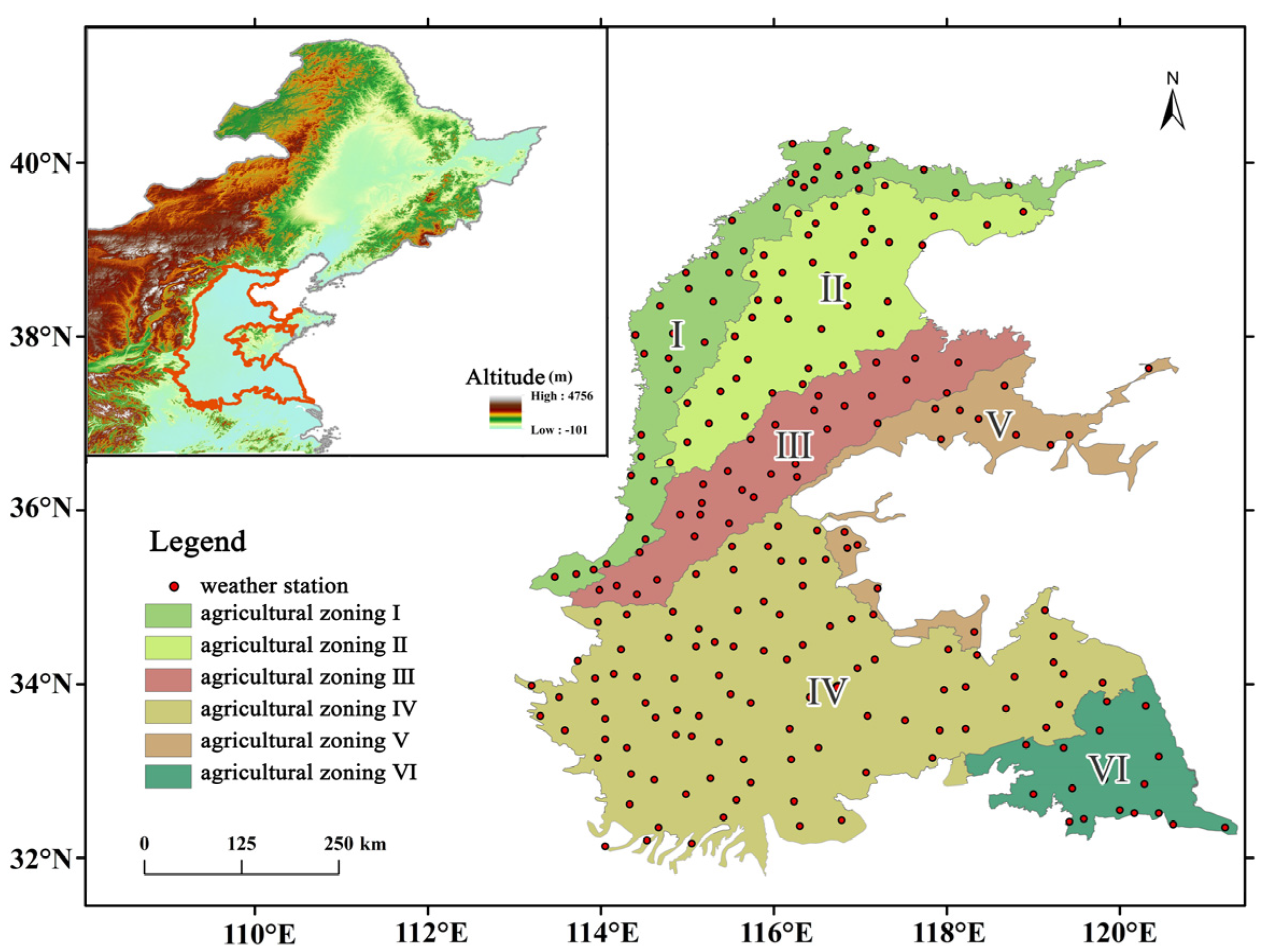
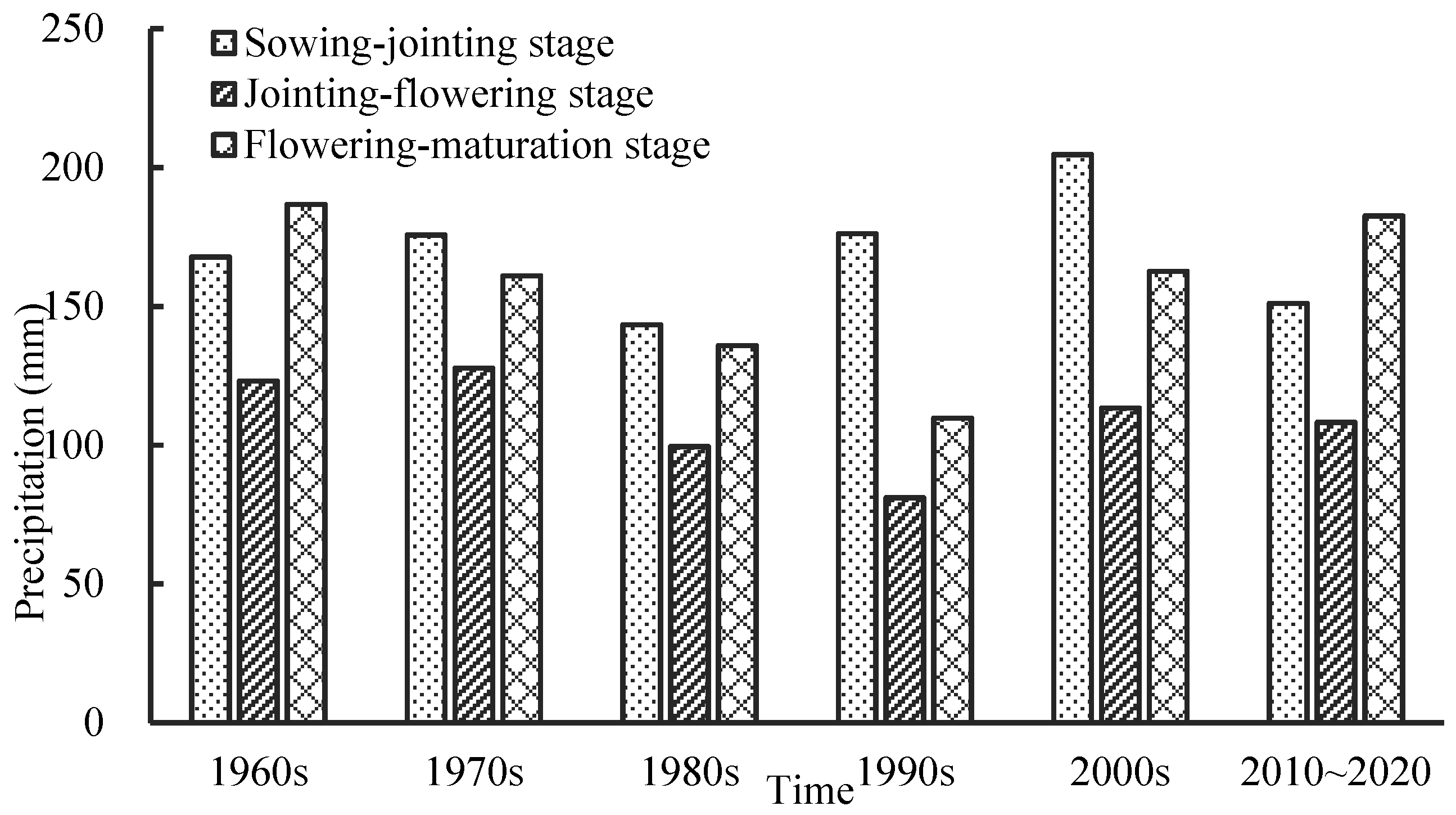
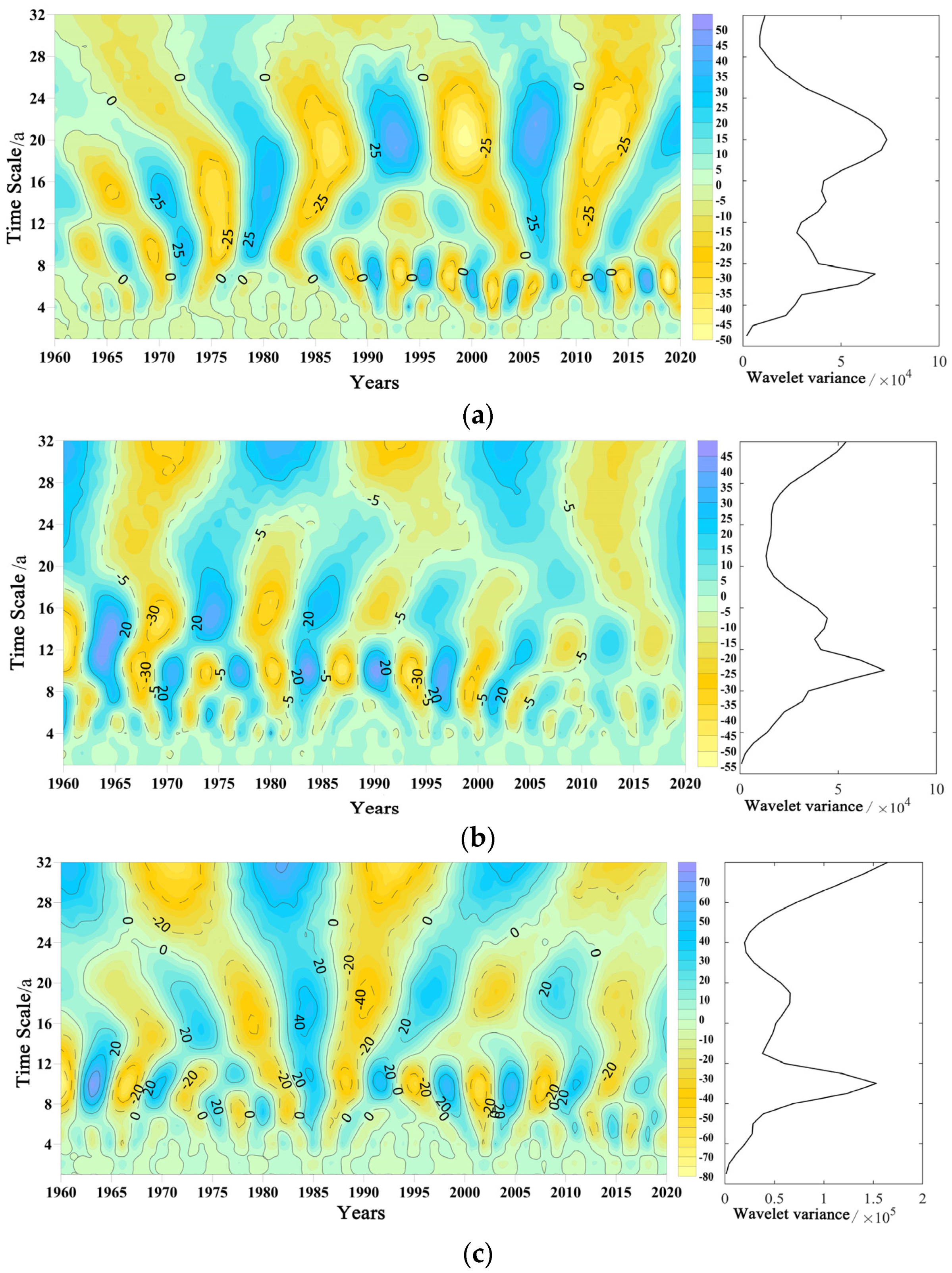
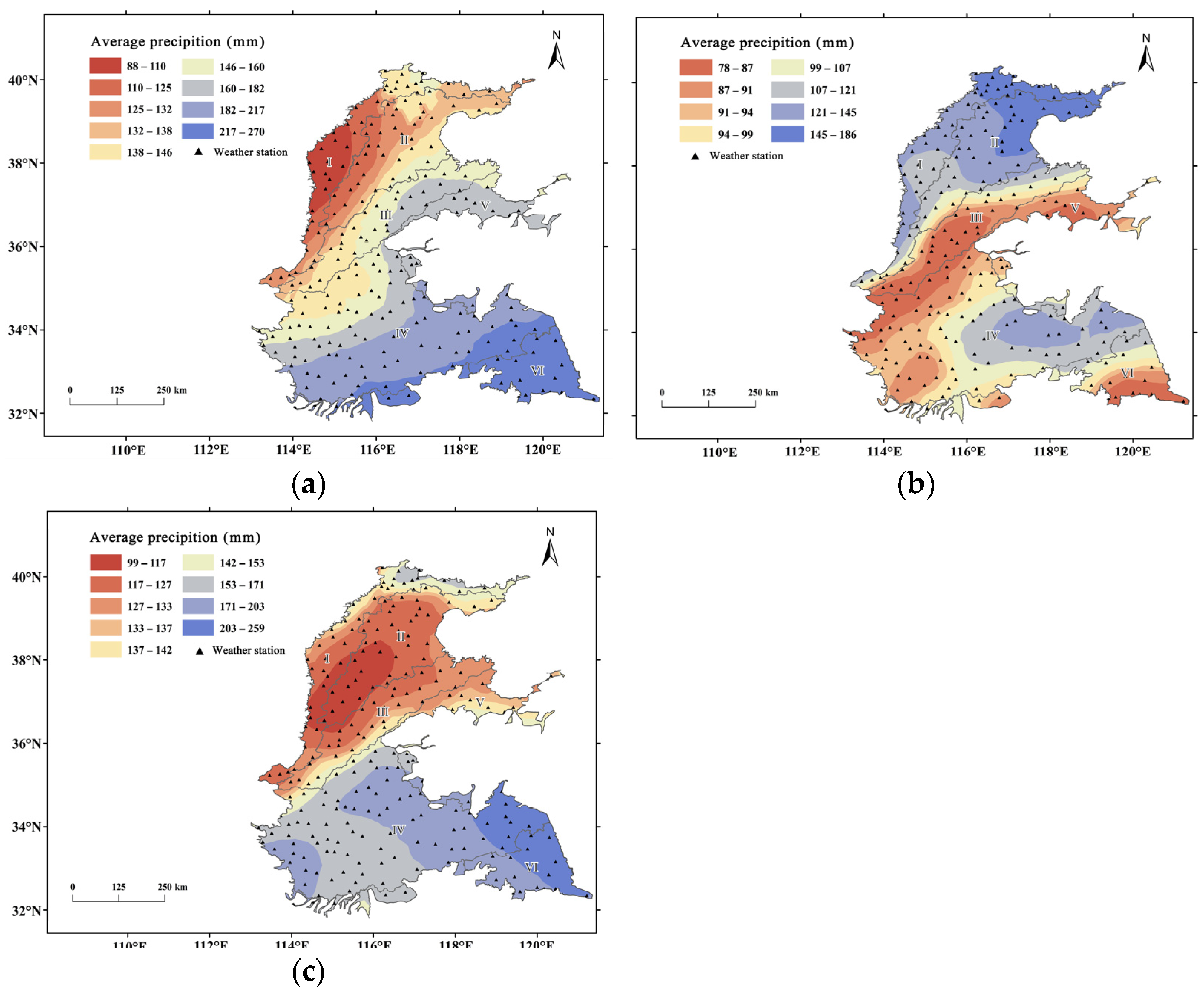
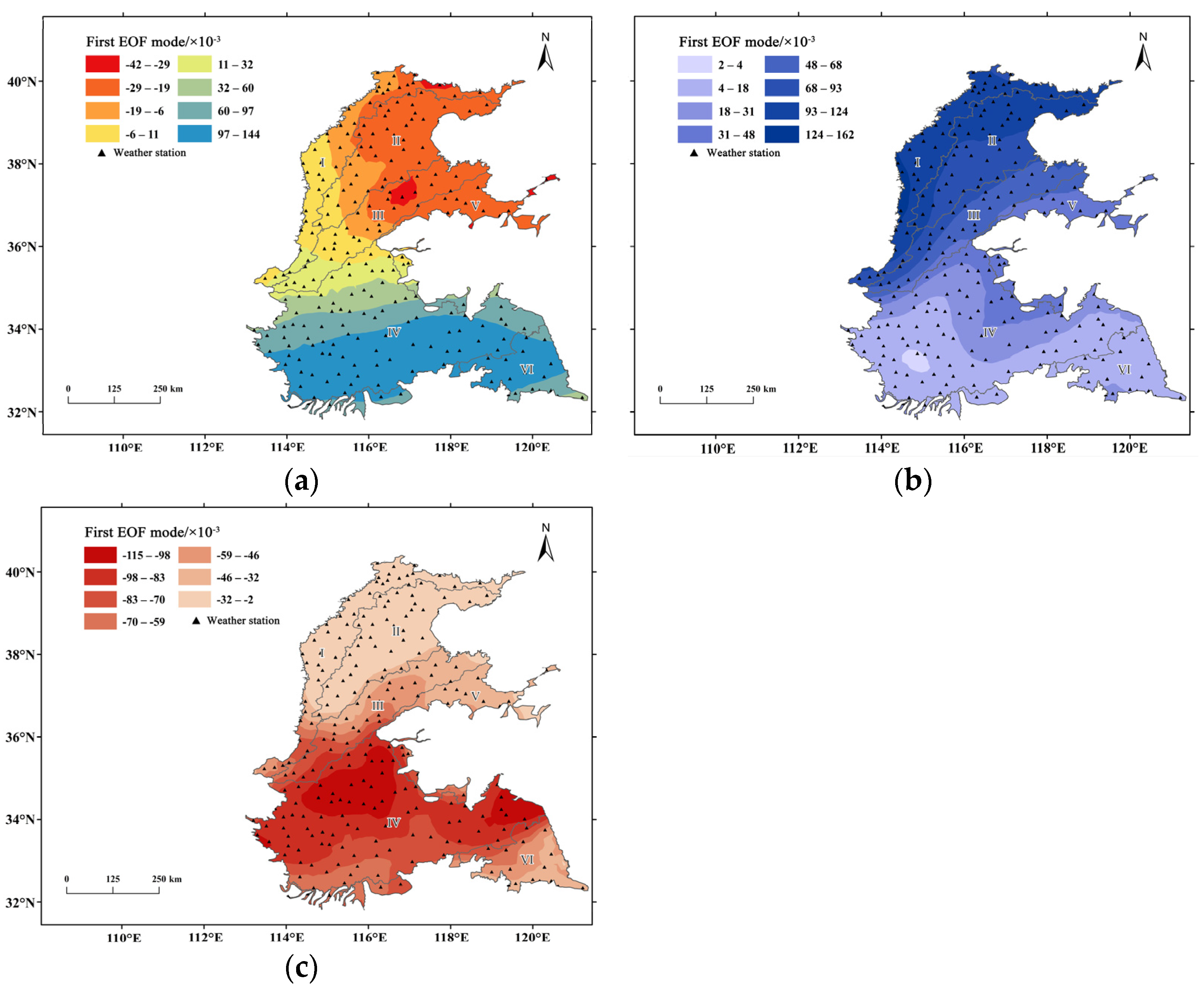
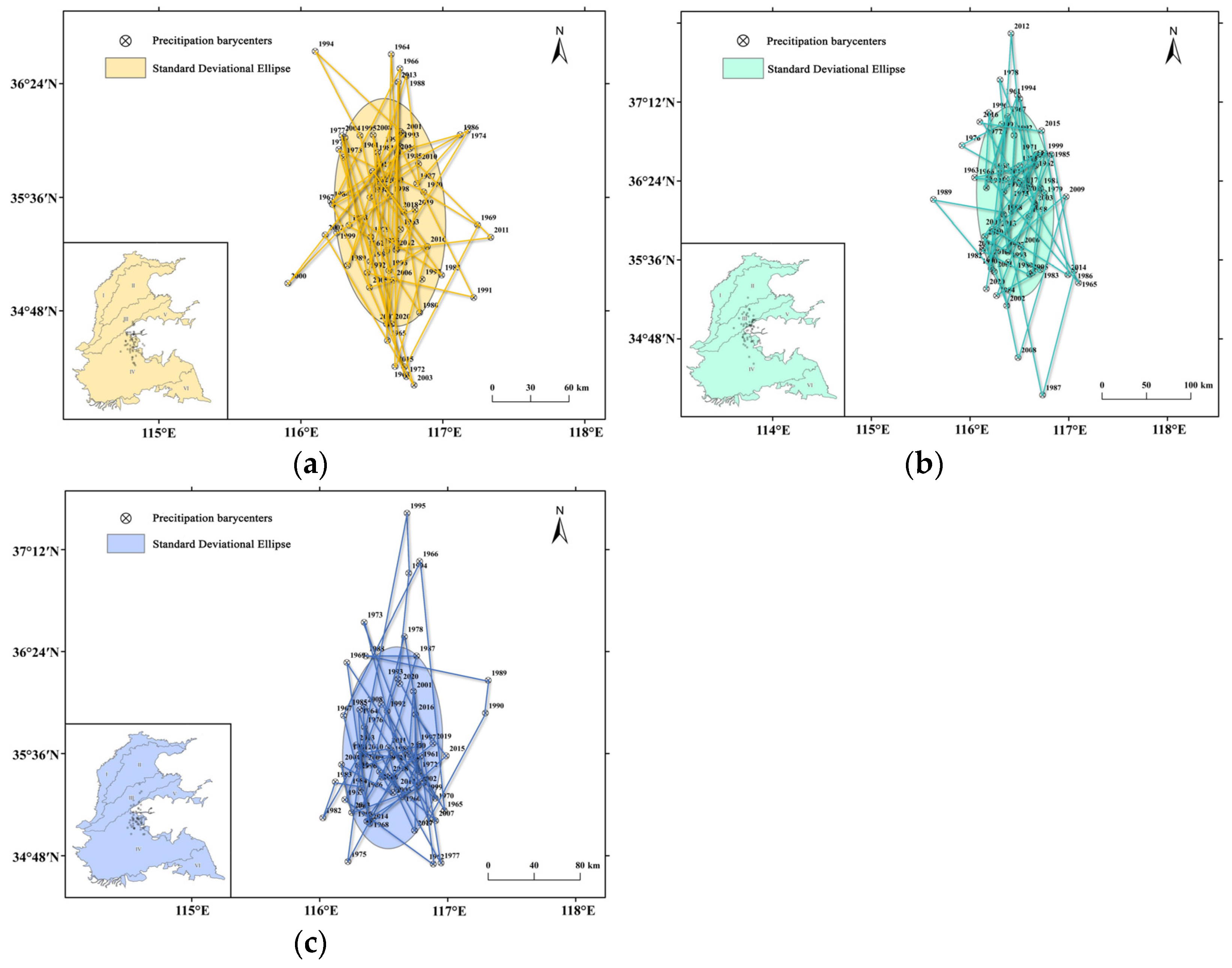
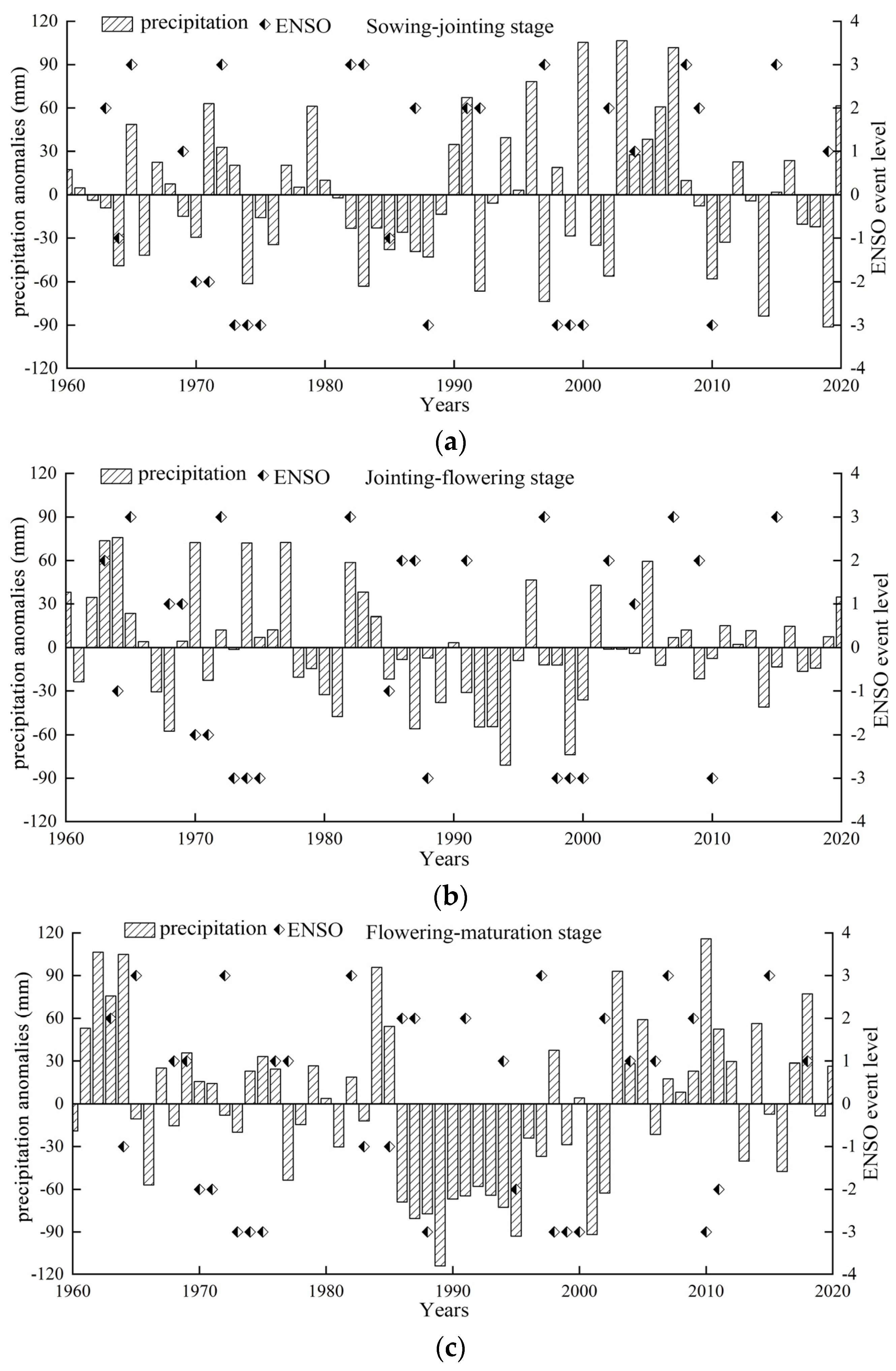
| Agricultural Cropping Region grade | Date of Sowing | Date of Jointing | Date of Flowering | Date of Maturation |
|---|---|---|---|---|
| I | 11 June | 14 July | 7 August | 24 September |
| II | 14 June | 18 July | 10 August | 28 September |
| III | 15 June | 23 July | 8 August | 23 September |
| IV | 12 June | 16 July | 2 August | 20 September |
| V | 16 June | 23 July | 9 August | 21 September |
| VI | 20 June | 20 July | 8 August | 25 September |
| Developmental Stage | Precipitation Range (mm) | Mean (mm) | Normally Distributed Statistical Variable (Z) | Variation Trend | Was it Significant (α = 0.1) |
|---|---|---|---|---|---|
| Sowing–jointing stage | 78.3–276.0 | 169.5 | −0.05 | Stable | No |
| Jointing–flowering stage | 27.8–184.7 | 108.8 | −1.08 | Decreased | No |
| Flowering–maturation stage | 42.7–272.7 | 156.9 | −0.14 | Decreased | No |
| Sowing–Jointing Stage | Jointing–Flowering Stage | Flowering–Maturation Stage | |
|---|---|---|---|
| Eigenvalue | 745,861 | 424,573 | 808,340 |
| Variance explained (%) | 31.6 | 25.9 | 38.0 |
| Developmental Stage | ENSO Warm Event | ENSO Cold Event | ||||
|---|---|---|---|---|---|---|
| Anomaly | Grade | Frequency | Deviation | Grade | Frequency | |
| Sowing–jointing stage | −26.15 | Weak | 3 | −43.51 | Weak | 2 |
| −18.57 | Medium | 6 | 16.78 | Medium | 2 | |
| −9.55 | Strong | 7 | 7.74 | Strong | 8 | |
| Jointing–flowering stage | −19.06 | Weak | 3 | −27.12 | Weak | 2 |
| −7.34 | Medium | 6 | 24.85 | Medium | 2 | |
| 12.62 | Strong | 6 | 7.34 | Strong | 8 | |
| Flowering–maturation stage | 0.31 | Weak | 8 | 49.10 | Weak | 3 |
| −29.68 | Medium | 6 | −2.65 | Medium | 4 | |
| −4.34 | Strong | 6 | 11.00 | Strong | 8 | |
| Developmental stage | AO | PDO | NAO | SOI | ONI |
|---|---|---|---|---|---|
| Sowing–jointing stage | 0.19 | −0.23 * | 0.01 | 0.08 | −0.11 |
| Jointing–flowering stage | 0.09 | −0.12 | 0.05 | 0.01 | −0.07 |
| Flowering–maturation stage | −0.10 | −0.23 * | −0.09 | 0.32 * | −0.19 |
Publisher’s Note: MDPI stays neutral with regard to jurisdictional claims in published maps and institutional affiliations. |
© 2022 by the authors. Licensee MDPI, Basel, Switzerland. This article is an open access article distributed under the terms and conditions of the Creative Commons Attribution (CC BY) license (https://creativecommons.org/licenses/by/4.0/).
Share and Cite
Wang, W.; Tang, S.; Han, H.; Xu, Y. Spatiotemporal Changes in Precipitation during the Summer Maize Growing Season in the North China Plain and Analysis of Its Causes. Atmosphere 2022, 13, 1288. https://doi.org/10.3390/atmos13081288
Wang W, Tang S, Han H, Xu Y. Spatiotemporal Changes in Precipitation during the Summer Maize Growing Season in the North China Plain and Analysis of Its Causes. Atmosphere. 2022; 13(8):1288. https://doi.org/10.3390/atmos13081288
Chicago/Turabian StyleWang, Wei, Shinan Tang, Hongbao Han, and Yiting Xu. 2022. "Spatiotemporal Changes in Precipitation during the Summer Maize Growing Season in the North China Plain and Analysis of Its Causes" Atmosphere 13, no. 8: 1288. https://doi.org/10.3390/atmos13081288
APA StyleWang, W., Tang, S., Han, H., & Xu, Y. (2022). Spatiotemporal Changes in Precipitation during the Summer Maize Growing Season in the North China Plain and Analysis of Its Causes. Atmosphere, 13(8), 1288. https://doi.org/10.3390/atmos13081288





